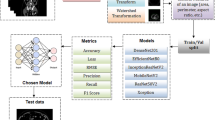Abstract
Purpose
To explore the diagnostic efficacy of MR-based texture analysis in differentiation of small (≤ 4 cm) and very small (≤ 2 cm) renal cell carcinoma subtypes.
Methods
One hundred and eight patients with pT1a (≤ 4 cm) renal cell carcinoma and pretreatment MRI were enrolled in this retrospective study. Histogram and gray-level co-occurrence matrix (GLCM) parameters were extracted from whole-tumor images. Among subtypes, patient age, tumor size, histological grading and texture parameters were compared. Diagnostic model using combination of texture parameters was constructed using logistic regression and validated using fivefold cross-validation. AUC with 95% CI, accuracy, sensitivity and specificity for subtype differentiation are reported. Further we explored the distinguishing ability of texture parameters and diagnostic model in very small (≤ 2 cm) RCC subgroups.
Results
Significant texture parameters among RCC subtypes were identified. For small (≤ 4 cm) renal cell carcinoma subtyping, combining models based on texture parameters achieved good AUCs for differentiating ccRCC vs. non-ccRCC, chRCC vs. non-chRCC and ccRCC vs. chRCC (0.79, 0.74 and 0.81). Further, in subgroups of very small (≤ 2 cm) RCCs, diagnostic models had better differentiating performances, achieving AUCs of 0.88, 0.99, 0.96 in differentiating ccRCC vs. non-ccRCC, chRCC vs. non-chRCC and ccRCC vs. chRCC.
Conclusion
MR texture analysis may help to differentiate small (≤ 4 cm) and very small (≤ 2 cm) RCC subtypes. This non-invasive method can potentially provide additional information for localized RCC treatment and surveillance strategy.
Graphical abstract


Similar content being viewed by others
References
Hsieh JJ, Purdue MP, Signoretti S et al (2017) Renal cell carcinoma. Nat Rev Dis Primers 3:17009
Antonio F, Nofisat I, Bill B et al (2016) Management of Small Renal Masses: American Society of Clinical Oncology Clinical Practice Guideline. J Clin Oncol 35:668-680
Campbell S, Uzzo RG, Allaf ME, et al (2017) Renal mass and localized renal cancer: AUA guideline. J Urol 198(3): 520-529
Ryan DW, Hajime T, Steven CC, Erick MR (2018) AUA Renal Mass and Localized Renal Cancer Guidelines: Imaging Implications. RadioGraphics 38:2021–2033
Moch H, Cubilla AL, Humphrey PA, Reuter VE, Ulbright TM (2016) The 2016 WHO classification of tumours of the urinary system and male genital organs-part a: renal, penile, and testicular tumours. Eur Urol 70:93-105
Jung JP, Chan KK (2017) Small (< 4 cm) Renal Tumors With Predominantly Low Signal Intensity on T2-Weighted Images: Differentiation of Minimal-Fat Angiomyolipoma From Renal Cell Carcinoma. Am J Roentgenol 208:124-130
Kohei S, Naoki T (2018) CT and MR imaging for solid renal mass characterization. Eur J Radiol 99:40-54.
Young JR, Coy H, Kim HJ et al (2017) Performance of relative enhancement on multiphasic MRI for the differentiation of clear cell renal cell carcinoma (RCC) from papillary and chromophobe RCC subtypes and oncocytoma. Am J Roentgenol 208:812-819
Miles KA, Ganeshan B, Hayball MP (2013) CT texture analysis using the filtration-histogram method: what do the measurements mean? Cancer Imaging 13:400-406
Castellano G, Bonilha L, Li LM, Cendes F (2004) Texture analysis of medical images. Clin Radiol 59:1061-1069
Ankur G, Abdul R, Devasenathipathy K et al (2019) Role of MR texture analysis in histological subtyping and grading of renal cell carcinoma: a preliminary study. Abdom Radiol, 44(10):3336-3349
Wei W, KaiMing Cao, ShengMing J et al (2020) Differentiation of renal cell carcinoma subtypes through MRI-based radiomics analysis. Eur Radio 30:5738-5747
Uyen NH, S. Mojdeh M, Osorio M et al (2018) Assessment of multiphasic contrast-enhanced MR textures in differentiating small renal mass subtypes. Abdom Radiol 43:3400-3409
Gillies RJ, Kinahan PE, Hricak H (2016) Radiomics: images are more than pictures, they are data. Radiology 278:563-577
Stephan U, Lucian B, Annemarie B et al (2020) Radiomics of computed tomography and magnetic resonance imaging in renal cell carcinoma—a systematic review and meta-analysis. Eur Radio 30:3558-3566
Cui E, Li Z, Ma C et al (2020) Predicting the ISUP grade of clear cell renal cell carcinoma with multiparametric MR and multiphase CT radiomics. Eur Radiol. 30(5):2912-2921
Yao Z, Shuai W, Yan C, Huiqian D (2021) Deep learning with a convolutional neural network model to differentiate renal parenchymal tumors: a preliminary study. Abdom Radiol 46:3260-3268
Xi IL, Zhao Y, Wang R, et al. (2020) Deep learning to distinguish benign from malignant renal lesions based on routine MR imaging. Clin Cancer Res 26(8):1944-1952
Meghan GL (2020) Radiomics and Artificial Intelligence for Renal Mass Characterization. Radiol Clin North Am 58(5):995-1008
Acknowledgements
Thanks to Dr. Jue Fan (Singeron Biotechnologies) for the consultation of the statistics.
Funding
This study is supported by Beijing Hope Run Special Fund of Cancer Foundation of China (LC2019B07), CAMS Innovation Fund for Medical Sciences (CIFMS) 2021-I2M-CT-B-059 and National Natural Science Foundation of China (81201701).
Author information
Authors and Affiliations
Corresponding author
Ethics declarations
Conflict of interest
We declared that all authors have no conflict of interest.
Additional information
Publisher's Note
Springer Nature remains neutral with regard to jurisdictional claims in published maps and institutional affiliations.
Supplementary Information
Below is the link to the electronic supplementary material.
Rights and permissions
Springer Nature or its licensor (e.g. a society or other partner) holds exclusive rights to this article under a publishing agreement with the author(s) or other rightsholder(s); author self-archiving of the accepted manuscript version of this article is solely governed by the terms of such publishing agreement and applicable law.
About this article
Cite this article
Wang, Y., Zhang, X., Zhang, J. et al. MR texture analysis in differentiation of small and very small renal cell carcinoma subtypes. Abdom Radiol 48, 1044–1050 (2023). https://doi.org/10.1007/s00261-022-03794-w
Received:
Revised:
Accepted:
Published:
Issue Date:
DOI: https://doi.org/10.1007/s00261-022-03794-w




